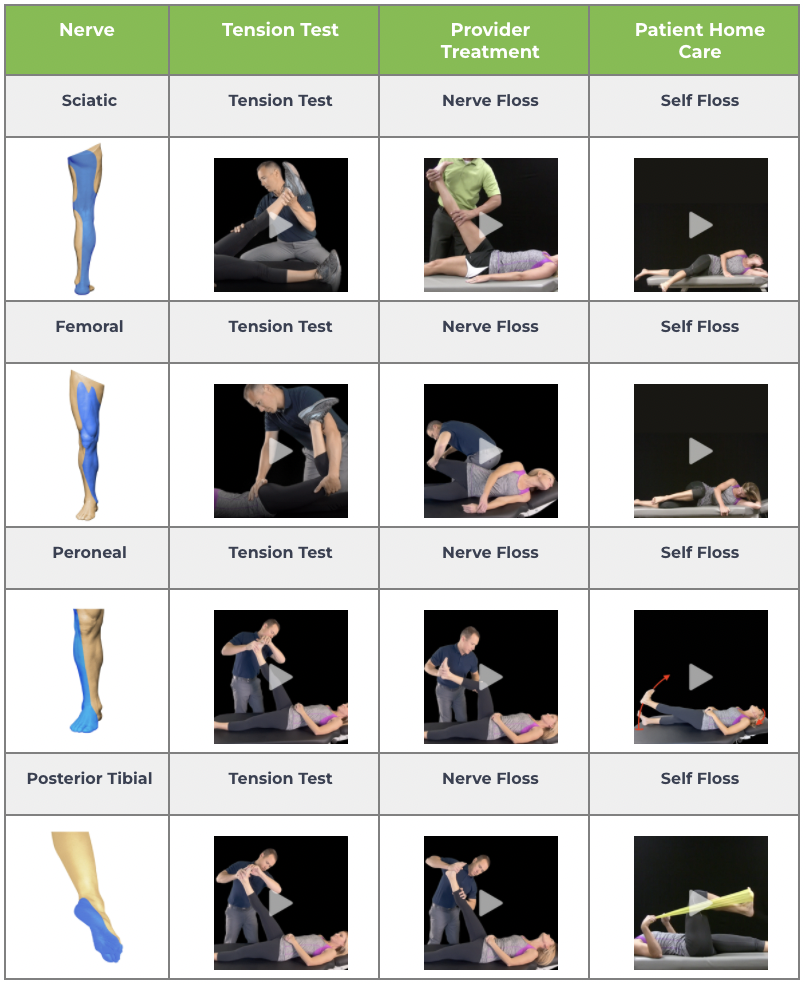4 Nerve Flossing Exercises for Back & Leg Pain Relief
Neurodynamics
Nerves are dynamic structures that need the ability to glide and stretch. (1) Edema and fibrosis can impair this normal nerve movement and often translate into neurogenic complaints. Nerve tension tests can help identify altered neurodynamics. Nerve flossing aims to restore normal neurodynamics and may help to resolve the associated symptoms.
A 2020 JMPT study found that more than 40% of extremity complaints arise from an asymptomatic spine. (2) Altered peripheral nerve mechanosensitivity/ neurodynamics is a likely culprit.
“According to the double-crush syndrome hypothesis, the peripheral nerves arising from irritated nerve roots are more sensitive to pressure.” (3) This cumulative nerve irritation is well recognized in neuropathies like sciatica but is also thought to contribute to peripheral joint and limb complaints, including anterior knee pain. (4)
The Assessment
Neurodynamic testing entails tensioning one or both ends of a selected nerve. The reproduction or increase in neurogenic symptoms indicates a positive test. (5,6)
Evidence-based chiropractors routinely manage lower extremity radicular pain. Sciatic nerve involvement can be readily identified via some familiar and reliable neurodynamic tests, including the SLR, Bragard, and Slump. (7) However, radiculopathies arising above L4 and many other lower extremity peripheral neuropathies will require alternate nerve tension tests.
For a refresher, check out this quick ChiroUp tutorial video of the most valuable & practical lower extremity neurodynamic tests.
Pro tip: Yes- there are far more than four nerve tension tests. ChiroUp subscribers can visit the Clinical Skills/ Evaluations tab for descriptions and tutorials on the other valuable nerve tension tests. And if you’re not yet a ChiroUp subscriber, you can try it today at no cost or risk, even if you’ve done a trial with us in the past. Click HERE to try us for FREE for 14 days.
Treatment
Neurodynamic treatments, including flossing, gliding, and tensioning, have been shown to provide substantial improvements in pain and ROM for lumbar spine-related neurogenic complaints: (8-10)
One systematic review of forty chronic low back pain studies found that nerve mobilization improved the average Oswestry score by 9.3 points and the average VAS by 1.8 points. (9) Other studies have shown additional benefits for peripheral joint complaints, flexibility, and even motor conduction velocity:
“increased hamstring flexibility to a greater degree than static hamstring stretching.” (11)
“a significant increase in femoral nerve motor conduction velocity and reduction of pain sensation.” (12)
> 90% of patellofemoral pain syndrome patients with positive femoral nerve tension tests showed significant improvement (>50%) after a single session of femoral nerve mobilization. (13)
What’s the difference between nerve tensioning and nerve flossing?
Nerve tensioning places both ends of a nerve under maximum stretch and is primarily used for testing purposes and occasional late-stage rehab.
Nerve flossing entails tensioning one end of the nerve while simultaneously releasing tension on the other end. This repetitive motion glides the nerve back and forth through its path and aims to release adhesions that have developed along the way. Therapeutic nerve flossing can be performed in-office by the clinician or as part of a home-based program.
Bottom line: Nerve mobilization works for LBP and peripheral complaints. Review the following chart for video demonstrations of practical in-office and home nerve flossing exercises that can help you improve your clinical outcomes for lower extremity complaints.
-
Wilgis EF, Murphy R. The significance of longitudinal excursion in peripheral nerves. Hand Clin. Nov 1986;2(4):761-6. Link
Rosedale R, Rastogi R, Kidd J, Lynch G, Supp G, Robbins SM. A study exploring the prevalence of Extremity Pain of Spinal Source (EXPOSS). Journal of Manual & Manipulative Therapy. 2020 Aug 7;28(4):222-30. Link
Okmen BM. et al. Investigation of the Effect of Cervical Radiculopathy on Peripheral Nerves of the Upper Extremity With High-Resolution Ultrasonography. SPINE. 43(14):E798–E803, JUL 2018 Link
Vegstein K, Robinson HS, Jensen R. Neurodynamic tests for patellofemoral pain syndrome: a pilot study. Chiropractic & manual therapies. 2019 Dec 1;27(1):26. Link
Butler D. The sensitive nervous system. Adelaide: Noigroup Publications; 2000. Link
Shacklock M. Clinical neurodynamics: a new system of neuromusculoskeletal treatment. Elsevier Health Sciences; 2005 May 6. Link
González Espinosa de Los Monteros FJ, Gonzalez-Medina G, Ardila EMG, Mansilla JR, Expósito JP, Ruiz PO. Use of Neurodynamic or Orthopedic Tension Tests for the Diagnosis of Lumbar and Lumbosacral Radiculopathies: Study of the Diagnostic Validity. Int J Environ Res Public Health. 2020 Sep 26;17(19):7046. doi: 10.3390/ijerph17197046. PMID: 32993094; PMCID: PMC7579046. Link
Alshami AM, Alghamdi MA, Abdelsalam MS. Effect of Neural Mobilization Exercises in Patients With Low Back-Related Leg Pain With Peripheral Nerve Sensitization: A Prospective, Controlled Trial. Journal of Chiropractic Medicine. 2021 Jun 1;20(2):59-69. Link
Basson A, Olivier B, Ellis R, Coppieters M, Stewart A, Mudzi W. The effectiveness of neural mobilization for neuromusculoskeletal conditions: a systematic review and meta-analysis. Journal of orthopaedic & sports physical therapy. 2017 Sep;47(9):593-615. Link
Almeida RS, Machado E, Yamato TP, Santos De Melo L, Nogueira LA. Pragmatic neural tissue management improves short-term pain and disability in patients with sciatica: a single-arm clinical trial. Journal of Manual & Manipulative Therapy. 2019 Aug 8;27(4):208-14. Link
Castellote-Caballero Y, Valenza MC, Puentedura EJ, Fernández-de-Las-Peñas C, Alburquerque-Sendín F. Immediate effects of neurodynamic sliding versus muscle stretching on hamstring flexibility in subjects with short hamstring syndrome. Journal of sports medicine. 2014 Apr 15;2014. Link
Hamed SA, Zoheiry IM, Waked NM, Mahmoud LS. Effect of Neurodynamics Nerve Flossing on Femoral Neuropathy in Haemophilic Patients: A randomized controlled study. Journal of Musculoskeletal & Neuronal Interactions. 2021;21(3):379. Link
Huang BY, Shih YF, Chen WY, Ma HL. Predictors for identifying patients with patellofemoral pain syndrome responding to femoral nerve mobilization. Archives of physical medicine and rehabilitation. 2015 May 1;96(5):920-7. Link

